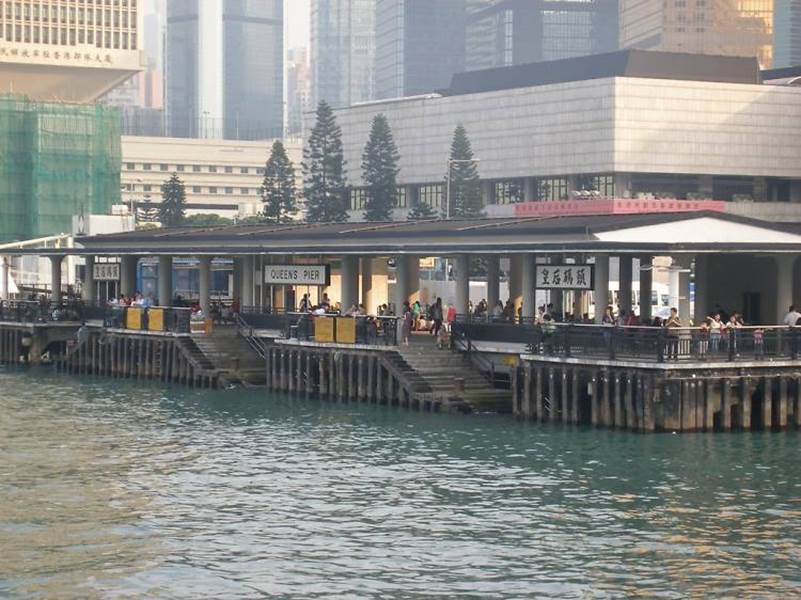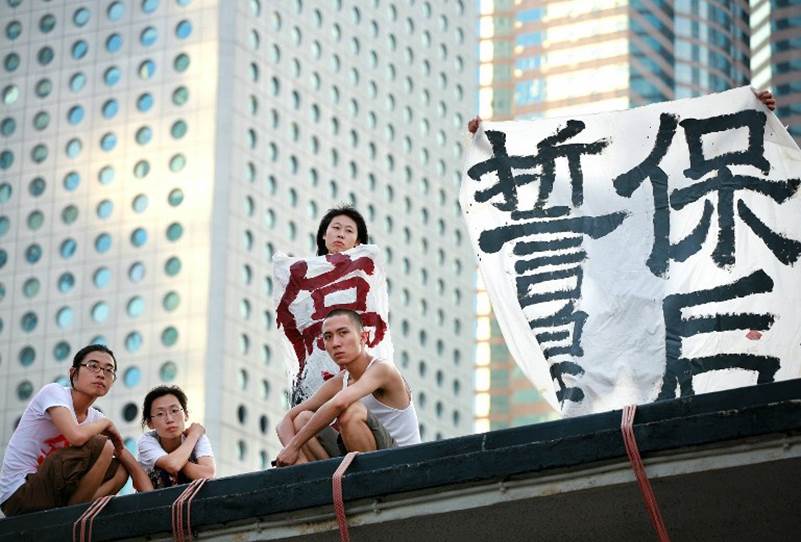1. Introduction
Queen’s Pier, built in 1925, was named after Queen Victoria. It served as a public pier, a recreation space, and acted as a major ceremonial arrival and departure point (Pang, 2020). The collective memories evolved from the Pier has shaped Hong Kong citizens’ collective identity. Unfortunately, Queen’s Pier was demolished for the sake of Central and Wan Chai Reclamation (“History of Central Reclamation”, n.d.). The demolition has provoked an unprecedented level of debate between the Hong Kong government and various parties (Chai, 2009). The values behind them would be illustrated.

Figure 1. Queen’s Pier was a significant part of Hong Kong’s history, providing a main arrival and departure point for many ceremonial occasions
(Photo by Time Out)
2. Cultural Geographical theory
2.0 Introduction
As the clash of values between different stakeholders regarding the Queen's Pier is going to be discussed, cultural geographical concepts related to the formation of certain values as well as the conflict between different parties should be introduced in order to explain the issue in-depth.
2.1 Locale (場所)
Locale refers to the environment of the place and the composite of all the traces that come together. It refers to daily lives settings and social interactions. Located at Victoria Harbour, Queen’s Pier witnessed the colonial period during the 20th century. During that period, different governors took the Lady Maurine, the government’s official yacht which took them across Victoria Harbour and then disembarked at Queen’s Pier (“Governor MacLehose takes office”, n.d.). Besides, several members of the British Royal Family arrived in Hong Kong at Queen’s Pier. Furthermore, the government organized celebrations at Queen’s Pier such as the military parade which celebrates the birthday of King George V (“中環皇后碼頭歷史”, n.d.). The colonial period has left many memorable traces at Queen’s Pier.
2.2 Sense of place (場所感)
Sense of place is the feeling towards a place. A place is not a place if it doesn’t stimulate senses to people who are present there. Sense of place is the bridge that connects people, culture and the location all together. Queen’s Pier gives the colonial sense to Hong Kong people, with its Western architectural style etc. It is a significant place of Western culture, which is deeply rooted in Hong Kong until now. Queen's Pier has given Hong Kong people a sense of belonging to colonial rule. And the presence of Queen’s Pier also reminds Hong Kong people of their diversed identity.
2.3 Resisting force and dominant power (抵抗力與主導權力)
The dominant power has the power to regulate what others do, somtimes by threatening them. The dominant power has the authority, be it lawfully, militarily and most importantly, culturally. To resist the authority, resisting force has arisen to challenge it. In the case of Queen’s Pier, the dominant power is the government while the resisting force is the general public, cultural and environmental conservationists. The resisting force adopts measures, such as publicity, rallies, hunger strike to resist the government’s demolition decision.
2.4 Cultural traces (文化印記)
A place is composed of various cultural traces and they reflect specific cultural orders, which is defined by the dominant power. The entire Queen’s Pier is composed of various cultural traces, such as the “Queen’s Pier” horizontal plaque, the banners and posters made by the resisting forces, the performances at the Queen’s Pier, etc. Cultural traces can be distinguished into lasting or transient, material or non-material. The plaque is material and lasting; the banners are material but transient; the performances are non-materialistic and transient. Nonetheless, trace together form a place.
2.5 Clash of cultures (碰撞)
After clashes of different cultures, these ever-changing traces allow the development of new places. The current building blocks of Queen’s Pier are located at the government explosive depots in Kau Shat Wan. While the old Queen’s Pier and Star Ferry Pier formed the current Central Pier No.9. Besides, the land obtained by reclamation as well as the Queen’s Pier are now developed into the AIA carnival.
2.6 Relationship between space and place (空間與地方的關係)
Professor Linda Hershkovitz pointed out that the tension between the hegemonic dominance of public space and the temporary appropriation as a mass stage is part of the social process. This tension may continue to produce and change the social space. When the time passes, the older cultural traces may be erased or merged with new traces, thus forming a complex cultural landscape (Hershkovitz, 1993).
3. Empirical analysis
3.1 Dominant power – Government

Figure 2. Queen’s pier
(Photo by SCMP pictures)
In the early 2000s, the Government decided to carry out Central Reclamation Phase III. One of the major infrastructures is the Central-Wanchai Bypass. To build the bypass, Queen’s Pier must be demolished so that reclamation can be done. Besides, the Secretary for Home Affairs Mr. Ho Chi-ping has stated that the historical, archaeological and palaeontological values of Queen’s Pier are not sufficient to be a declared monument. Although the Antiquities Advisory Board has ranked the Pier as a Grade 1 Historical Building, the government chose to neglect the Board’s opinions.
The Secretary for Development, Carrie Lam, claimed that Hong Kong has a high population density. Hence, city planning is very important. It was urgent to start the Central Reclamation Phase III to alleviate transportation needs. This shows that the government prioritizes economic development over heritage protection.
From the cultural geographic aspect, the government establishes cultural order through traces to control one place. Even though these wishes or thoughts are not necessarily fair, the government may impose them on citizens through punishments. In fact, when citizens went to Queen’s Pier to participate in protests, like hunger strike, Queen’s Pier was temporarily used as a stage for the masses. The police then banished the protesters by force to redefine and control the place.
3.2 Resisting Power
3.2.1 Citizens
Three values are reflected from citizens, namely sense of belonging, increased awareness on cultural conservation and political awakening.
For sense of belonging, Queen's Pier signifies the identity of Hong Kong citizens as the citizens of British colony. (鄭, 2016) This can be explained by the locale of Queen's Pier as mentioned above. An increased awareness on cultural conservation is also shown. In the past, economic gain outweighed cultural heritage and many historical buildings were demolished. Later, citizens started to place more emphasis on the non-material quality of life, hence resulted in the increased awareness on cultural conservation, exhibited by other preservations like Blue House and Tai Kwun.
As citizens started to focus on non-material quality of life, they wanted to exercise their political rights and participate in decision-making(Ewing, 2020).. Therefore, they began to participate in protests to express their demands.

Figure 3. People are holding banners with the words “Preserve Queen’s pier” on July 30
(Photo by Samantha Sin/AFP)
3.2.2 Cultural Conservationist
There are three values reflected by the cultural conservationist, which are heritage completeness, location of heritage and the democracy of city planning respectively.
For heritage completeness, the government once proposed a plan to conserve only specific parts of Queen’s Pier, making symbolic cultural heritage incomplete, the cultural conservationists strongly oppose the suggestion, meaning that they value the completeness of Queen’s Pier to a large extent for arousing collective memory.
For the location of heritage, the government believes that there is a need to demolish the whole pier due to construction work. However, cultural conservation group The Conservancy Association proposed that the government can temporarily move the pier away and assemble them at the original location after the construction. This proposal is rejected by the government due to the high cost involved, but it can show that cultural conservationists think that the location of the heritage is directly associated with its culture and history.
Lastly, the cultural conservationists believe that they do not have the freedom to take part in the process of city planning. They believe that the “Antiquities and Monuments Ordinance” is outdated and the statements inside are ambiguous, causing the government to have sole control towards city planning. Moreover, the cultural conservationist stated that the Antiquities Advisory Board and the Antiquities and Monuments Office exist but without a concrete use. Therefore, they fail to take part in their valued city planning.
3.2.3 Environmentalists
There are two values reflected from environmental conservation groups, which are conservation of the environment and protection of marine life.
For the conservation of the environment, Action Group on Protection of the Harbour organised a Blue Ribbon Movement on 22nd December in 2016. Members from the environmental group as well as citizens tied blue ribbons on the fences along the Victoria Harbour. This showed their strong will in protecting the Queen’s Pier such that the whole Victoria Harbour scenery can be conserved. On the same day as the Blue Ribbon movement, members from the legislative council and district councils as well as citizens go on board. This boarding action was to show their opposition towards the reclamation of the Victoria Harbour as it will pollute the sea water, thus affecting marine life. Therefore, they value the protection of marine life.
4. Conclusion
Looking at the demolition of the Queen’s Pier through a geographical perspective, we have gained deeper insight on the issue. The cultural landscape of Queen’s Pier region that we see today are formed by constant clash of culture between different cultural groups, and the appearance of the landscape is a fusion of values from different stakeholders. It is recommended that for future city development plans of the government, understanding values of different cultural groups is crucial and as policy makers, the government truly has the duty to respect and integrate all the values.
References
Chai, K. (2009, January 01). Central Star ferry pier: Policy, politics and protest in the making of heritage in Hong Kong. Retrieved December 05, 2020, from http://hub.hku.hk/handle/10722/152558
Emmerton, R. (2016). Put Queen’s Pier close to its original location on Hong Kong Island. South https://www.scmp.com/comment/letters/article/1951659/put-queens-pier-close-its-original-location-hong-kong-island
Hershkovitz, L. (1993). Tiananmen Square and the politics of the place. Political Geography, 12(5), 395-420. https://doi.org/10.1016/0962-6298(93)90010-5
Pang, J. (2017). In Pictures: Demonstrations and demolition-10 years since the Queen’s Pier was pulled down. Hong Kong Free Press. https://hongkongfp.com/2017/08/06/pictures-demonstrations-demolition-10-years-since-queens-pier-pulled/
Time Out Hong Kong. (2020). Hong Kong’s Lost Buildings. Time Out. https://www.timeout.com/hong-kong/attractions/hong-kongs-lost-buildings
香港記憶: Hong Kong Memory. (n.d.). Retrieved December 07, 2020, from https://www.hkmemory.hk/MHK/collections/MemoriesWeShare/live_broadcasts/governor_macLehose_takes_office/index.html
中環皇后碼頭歷史和建築賞析. (n.d.). Retrieved December 05, 2020, from https://www.aab.gov.hk/form/AAB_Paper129_queen_annexb_c.pdf
香港皇后碼頭清場完畢 三人被捕 (2007, August 2) .). Retrieved December 25, 2020, from http://news.bbc.co.uk/chinese/trad/hi/newsid_6920000/newsid_6927100/6927167.stm
鄭, 威鵬. (2016, October 30). 無法解殖的後殖民﹕天星及皇后碼頭運動的空間政治 (討論提綱). Retrieved December 23, 2020, from https://angelland3.wordpress.com/2016/10/29/
Ewing, K. (2020, March 31). Out with the old: The political awakening of a new generation of Hongkongers. Retrieved December 23, 2020, from https://hongkongfp.com/2016/03/27/out-with-the-old-the-political-awakening-of-a-new-generation-of-hongkongers/


